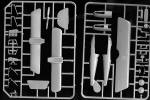
| KIT #: | EC 7204 |
| PRICE: | $9.99 MSRP |
| DECALS: | One option |
| REVIEWER: | Scott Van Aken |
| NOTES: | Roden mold |

| HISTORY |
Deliveries to operational units began in August 1917. Jasta 10 was the first recipient of the new aircraft, followed by Jasta 4. While markedly better than the earlier Roland designs, the D.III was generally considered inferior to the Albatros D.III and D.V. German pilots variously criticized the Pfalz’s heavy controls, low speed, lack of power, or low rate of climb compared to the Albatros.The D.III slipped in turns, leading to crashes when unwary pilots turned at very low altitudes. Moreover, the Pfalz stalled sharply and spun readily. Recovery from the resulting flat spin was difficult, though some pilots took advantage of this trait to descend quickly or evade enemy aircraft.
The Pfalz’s primary advantage was its strength and sturdiness. The Albatros scouts were plagued by failure of their single-spar lower wings.The Pfalz, however, could safely dive at high speeds due to its twin-spar lower wing. For this reason, the Pfalz was well-suited to diving attacks on observation balloons, which were usually heavily defended by anti-aircraft guns trained to the balloon's altitude.
The most pressing complaint about the new Pfalz was that the guns were buried in the fuselage, preventing pilots from clearing gun jams in flight. This feature had been carried over from the earlier Roland designs.In November 1917, Pfalz responded by producing the slightly modifiedD.IIIa, which relocated the guns to the upper fuselage decking.The D.IIIa was distinguishable by its enlarged semicircular horizontal stabilizer and cropped lower wingtips. It also featured a more powerful version of the Mercedes D.III engine.
Pfalz built approximately 260 D.III and 750 D.IIIa aircraft.Most were delivered to Bavarian Jastas. Once Pfalz completed the final batch in May 1918,production shifted to the D.IIIa's successor, the D.XII. Some aircraft from the final D.IIIa batch were delivered to Turkey.
As of 30 April 1918, 433 D.IIIa scouts were still in frontline use. By 31 August, that number had declined to 166. Many serviceable aircraft were sent to advanced training schools, but approximately 100 aircraft remained in frontline use at the time of the Armistice.
| THE KIT |
 From the looks of things, this is a Roden kit. It makes sense as Squadron has a good working relationship with Roden and those 1/32 Encore kits are based on Roden products. This is the first I've seen of their inexpensive EconoKits, though there have been three others produced, according to the advert on the back of the bag. Yes, this is a header bagged kit, something not seen in quite some time, but a fine way to cut on costs and provide a kit for what now passes as pocket money.
From the looks of things, this is a Roden kit. It makes sense as Squadron has a good working relationship with Roden and those 1/32 Encore kits are based on Roden products. This is the first I've seen of their inexpensive EconoKits, though there have been three others produced, according to the advert on the back of the bag. Yes, this is a header bagged kit, something not seen in quite some time, but a fine way to cut on costs and provide a kit for what now passes as pocket money.
The kit itself is fairly well molded, though it is obvious it has seen a lot of mold cycles. There is some flash on a few of the pieces and while the rest of them are OK, the detailing is a bit softer than what one would expect from a brand new mold kit. Aside from a different upper engine cowling, and two different tailplanes, there is not much in the way of optional parts. The different tail planes and engine cowling may be what differentiates a D.III from a D.IIIa.
Instructions are well done and offer any modifications needed. There is a full color markings placement guide. What makes this kit a bit more unusual is that it depicts an aircraft built for the movie 'The Blue Max'. As such, one will need to make the adjustments required as it was really more of a representation of the Pfalz D.III than the actual aircraft. That is why it comes with such colorful and non-specific camouflage. Encore has had Cartograf produce an excellent decal sheet that is basically all the lozenge found on the movie aircraft. It is not accurate for real WWI planes, but has the exact colors used in the movie plane. I should also mention that the instructions include a full rigging guide.
| CONCLUSIONS |
Frankly, this is a neat kit and I'm glad to see a company producing a variation that was used in movies. It may be cause to see other movie aircraft, especially if in this inexpensive line of kits. For those who have aftermarket decals, it is a good way to get a kit so you can use up what you have. A neat idea and one that I think you should support.
| REFERENCES |
December 2009
Thanks to Squadron Products for the preview sample. Get yours at your local shop. If you would like your product reviewed fairly and fairly quickly, please contact the editor or see other details in the Back to the Previews Index Page